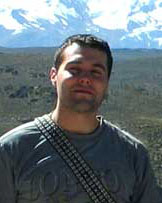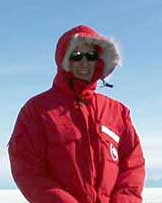Nevado Firura Glacier, Peru
This Project is supported by a generous grant from the
Dan and Betty Churchill Exploration Fund
June 15, 2005 to July 14, 2005


6th-10th July
Mauca Llacta to Arequipa



click on images to view larger
6th – 8th July:
Kurt writes: Saul arrived in Mauca Llacta the morning of July 6th and we eagerly set out to climb the Nevado Coropuna, the third highest mountain in Peru at 6,426 m (21,083 feet) elevation. After that bit of relaxation, we made our way via 4x4 across the highlands through the Valle de los Volcanes to the town of Chivay in the Colca Canyon. We went to the Colca to study an unusual labyrinthine terrain, identified by Hal Borns during his visit to the area several years ago. This labyrinthine terrain is known only to occur in one other place – Antarctica.
9th – 10th July:
Gordon writes: We’ve just spent a couple of days in Chivay, which is a bustling little highland town thronged with western tourists. The purpose of this detour was to observe a peculiar area of labyrinth terrain that may have an ancient glacial origin. Within this cacti-infested area of steep knolls and deep troughs we also found walled fields, canals, terraced hillsides, and stone huts, all part of an Inca site called Sol de Sacsayhuama (Quechua for "high ground to attack which provides corpses for vultures"). Strangely enough, not a single tourist (ourselves excepted) was in sight at this amazing place. Now the plan is to make the four hour bus trip back to Arequipa, where we can relax at La Casa de Melgar and celebrate the end of a very successful and well-orchestrated field season.
This project owes its success to many people, both in Peru and at home in Maine. The team would like to thank Dan and Betty Churchill, the Association of Graduate Students, and the UMaine Department of Anthropology and Climate Change Institute for funding, Louis Morin and Bill Congleton of UMaine for GPS equipment, our advisors Dan Sandweiss, Brenda Hall, and Hal Borns and all our friends and colleagues in Peru for their help and hospitality.
